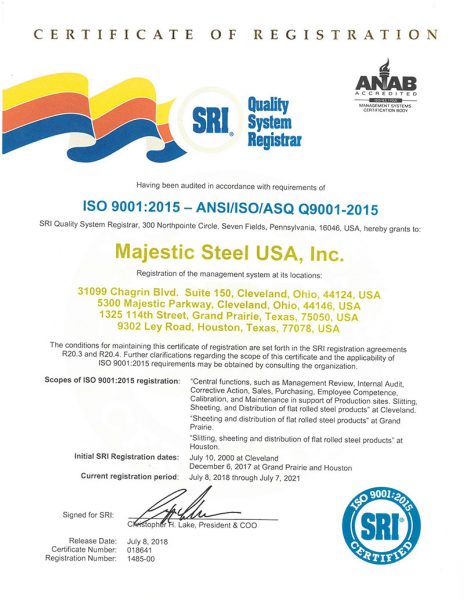Market Update | November 16, 2022
NEW ALL-TIME HIGH FOR MONTHLY RETAIL SALES
After a flat reading in September, retail sales increased at its highest rate since March. October sales came in at a $694.5 billion rate, up 1.3% from September and up 8.3% from a $641.5 billion rate in October 2021. This is a new all-time high for adjusted monthly retail sales. The largest increases in sales, compared to September, came from gasoline stations, bars and restaurants, building material stores, and online retailers.
Input Costs
A potential easing of their COVID-0 policy in China, combined with a weaker U.S. dollar helped key base metal and rate materials rebound this week after sharp declines the previous couple of weeks.
As the recent up and down movement for zinc continues, pricing rebounded for the second consecutive week.
-
-
Zinc pricing came in at $1.31/lb this week, its highest level since mid-September.
-
Spot iron ore pricing rebounded once again this week, climbing to $95.70 /mt this week.
-
-
This is up 6.9% from the end of last week and is up 2.1% on a m/m basis.
- Bearish conditions, recession risks and slowdowns in China, will likely affect the steel industry during Q4 and thus limit iron ore demand.
-
Pacific Basin met coal pricing declined again this week, sliding to $285/mt.
-
-
Current pricing is down 10.4% from the end of last week and is down 0.5% from this time last month.
-
Supply
After sliding to a near two-year low last week, domestic raw steel production inched slightly higher last week.
-
- U.S. steelmakers produced 1.645 million tons at an 73.7% utilization rate.
- Despite the slight week-over-week increase, YTD production is now down 4.9% from the same time last year.
- YTD production is now down 4.8% from the same time last year.
Based on preliminary import license data, the daily average (14 days) shows flat rolled steel imports were down 15.4% compared to the same timeframe in October.
-
- Excluding the volatile semi-finished products, imports were up 16.5% compared to October.
Nucor announced that it is joining the United Nations 24/7 Carbon-Free Energy Global Compact (“Compact”).
-
- Nucor is the first major industrial company to join this global effort, which is aimed at accelerating the decarbonization of the world’s electricity systems to mitigate climate change and ensure access to clean and affordable electricity.
- To further its commitment, Nucor is working with its electricity suppliers to access 24/7 clean energy at the company’s steel mills.
DEMAND
After declining the previous three months, business activity, from the manufacturing sector, in the New York region showed slight growth.
-
-
The November Empire Manufacturing Index came in at 4.5, up from -9.1 in October.
-
The two-month average remained below 0.0 however, coming in at -2.3.
- Any reading above 0.0 indicates growing in activity, while any reading below 0.0 denotes a decline.
- The largest increase in November came from the shipment component.
- While the shipment component expanded, both the new order and unfilled order components continued to decline.
- Looking forward, the index for future business conditions declined to -6.1, down from – 2.1 previously.
-
Total industrial production slipped in October, sliding 0.1% to 104.7 and the previous months were revised slightly lower.
-
-
Manufacturing output increased slightly however, climbing 0.1% in October to 102.3 and was up 2.4% from October 2021.
-
The index for durable good manufacturing increased 0.5%.
- While the overall capacity utilization rate slipped to 79.9% from 80.1% previously.
- Utilization for manufacturing was flat at 79.5% and remains above the long-range average of 78.2%.
-
ECONOMIC
After peaking in August, the Cass Freight Shipment Index has softened over the last two months.
-
-
The October Shipment Index came in at 1.224, down from 1.241 in September but up from 1.189 in October 2021.
-
The Expenditure Index (which measures total cost) declined as well, sliding nearly 5.0% from September.
- While down from September, the Expenditure Index was up on a year-over-year basis.
- The Inferred Freight Rates (expenditures divided by shipments) slipped 3.6% in October.
- The leveling off of freight rates, combined with a loosening of the tight truck driver shortage helped soften overall costs.
- The Fed Reserve Vice Chair, Lael Brainard, noted this week that the pace in which the recent rate hikes have been coming, may be slowing soon.
- Vice Chair Brainard noted that it may be time to slow the increases to 50 basis points, down from the previous couple increases of 75 basis points.
- The slowing of increases may be a positive for consumers and business alike as they plan for 2023.
- After a flat reading in September, retail sales increased at its highest rate since March in October.
- October sales came in at a $694.5 billion rate, up 1.3% from September and up 8.3% from a $641.5 billion rate in October 2021.
- This is a new all-time high for adjusted monthly retail sales.
- The largest increases in sales, compared to September, came from gasoline stations, bars and restaurants, building material stores, and online retailers.
- These increases helped overcome declines from department stores, and electronic stores.
-
This material, information and analyses (the “Content”) may include certain statements, estimates and projections prepared with respect to, among other things, historical data and anticipated performance. Content may reflect various assumptions by Majestic Steel USA, Inc. concerning anticipated results that are inherently subject to significant economic, competitive and other uncertainties and contingencies and have been included for illustrative purposes. Content is provided AS-IS.

